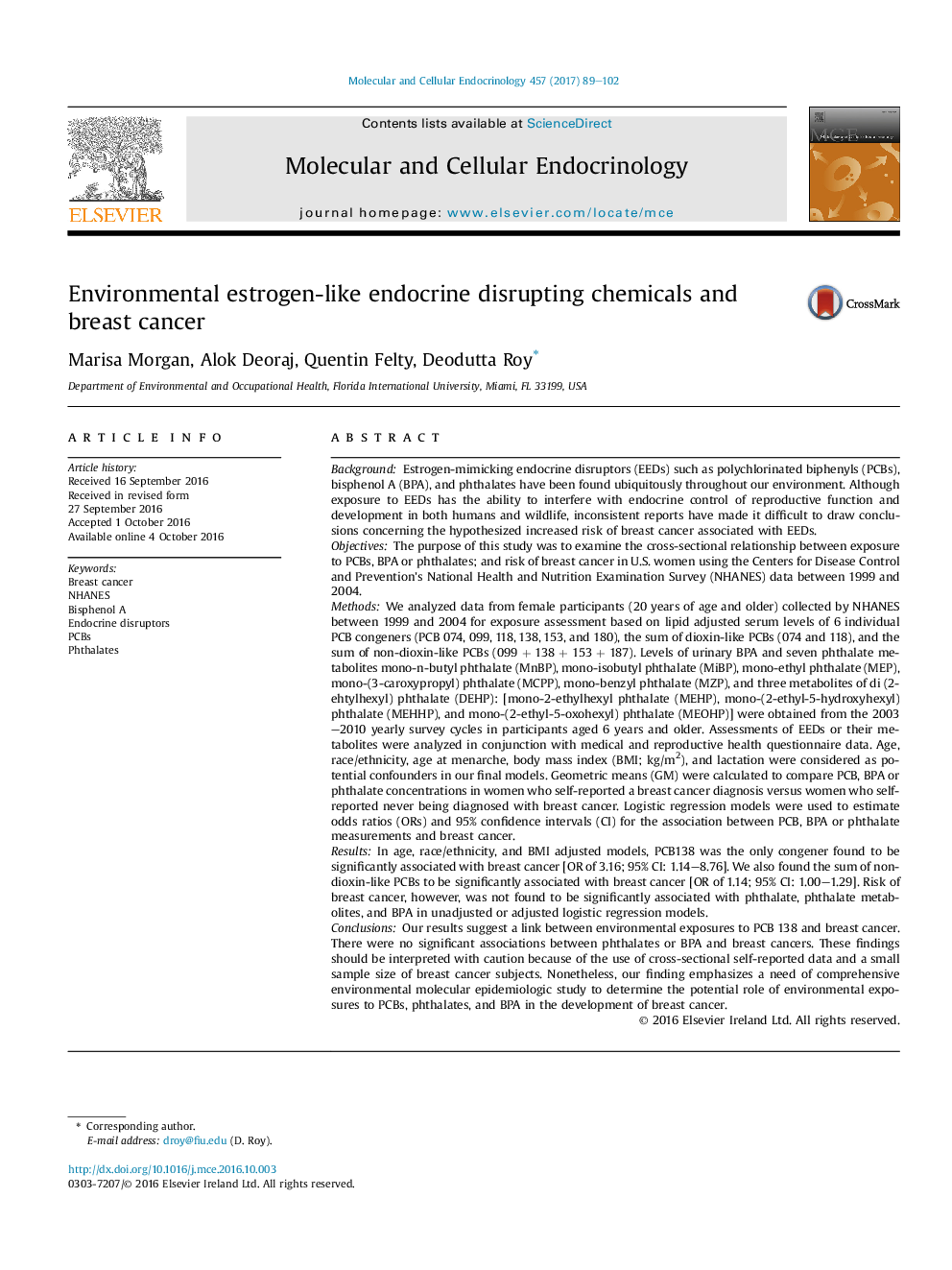| کد مقاله | کد نشریه | سال انتشار | مقاله انگلیسی | نسخه تمام متن |
|---|---|---|---|---|
| 5533989 | 1550822 | 2017 | 14 صفحه PDF | دانلود رایگان |
- Cross-sectional relationship between PCBs, BPA or phthalates and risk of breast cancer was examined.
- Association between environmental exposure to PCB 138 and breast cancer was demonstrated.
- Self-reported data and small sample size of breast cancer subjects are the limitations in the interpretation of results.
BackgroundEstrogen-mimicking endocrine disruptors (EEDs) such as polychlorinated biphenyls (PCBs), bisphenol A (BPA), and phthalates have been found ubiquitously throughout our environment. Although exposure to EEDs has the ability to interfere with endocrine control of reproductive function and development in both humans and wildlife, inconsistent reports have made it difficult to draw conclusions concerning the hypothesized increased risk of breast cancer associated with EEDs.ObjectivesThe purpose of this study was to examine the cross-sectional relationship between exposure to PCBs, BPA or phthalates; and risk of breast cancer in U.S. women using the Centers for Disease Control and Prevention's National Health and Nutrition Examination Survey (NHANES) data between 1999 and 2004.MethodsWe analyzed data from female participants (20 years of age and older) collected by NHANES between 1999 and 2004 for exposure assessment based on lipid adjusted serum levels of 6 individual PCB congeners (PCB 074, 099, 118, 138, 153, and 180), the sum of dioxin-like PCBs (074 and 118), and the sum of non-dioxin-like PCBs (099Â +Â 138Â +Â 153Â +Â 187). Levels of urinary BPA and seven phthalate metabolites mono-n-butyl phthalate (MnBP), mono-isobutyl phthalate (MiBP), mono-ethyl phthalate (MEP), mono-(3-caroxypropyl) phthalate (MCPP), mono-benzyl phthalate (MZP), and three metabolites of di (2-ehtylhexyl) phthalate (DEHP): [mono-2-ethylhexyl phthalate (MEHP), mono-(2-ethyl-5-hydroxyhexyl) phthalate (MEHHP), and mono-(2-ethyl-5-oxohexyl) phthalate (MEOHP)] were obtained from the 2003-2010 yearly survey cycles in participants aged 6 years and older. Assessments of EEDs or their metabolites were analyzed in conjunction with medical and reproductive health questionnaire data. Age, race/ethnicity, age at menarche, body mass index (BMI; kg/m2), and lactation were considered as potential confounders in our final models. Geometric means (GM) were calculated to compare PCB, BPA or phthalate concentrations in women who self-reported a breast cancer diagnosis versus women who self-reported never being diagnosed with breast cancer. Logistic regression models were used to estimate odds ratios (ORs) and 95% confidence intervals (CI) for the association between PCB, BPA or phthalate measurements and breast cancer.ResultsIn age, race/ethnicity, and BMI adjusted models, PCB138 was the only congener found to be significantly associated with breast cancer [OR of 3.16; 95% CI: 1.14-8.76]. We also found the sum of non-dioxin-like PCBs to be significantly associated with breast cancer [OR of 1.14; 95% CI: 1.00-1.29]. Risk of breast cancer, however, was not found to be significantly associated with phthalate, phthalate metabolites, and BPA in unadjusted or adjusted logistic regression models.ConclusionsOur results suggest a link between environmental exposures to PCB 138 and breast cancer. There were no significant associations between phthalates or BPA and breast cancers. These findings should be interpreted with caution because of the use of cross-sectional self-reported data and a small sample size of breast cancer subjects. Nonetheless, our finding emphasizes a need of comprehensive environmental molecular epidemiologic study to determine the potential role of environmental exposures to PCBs, phthalates, and BPA in the development of breast cancer.
Journal: Molecular and Cellular Endocrinology - Volume 457, 5 December 2017, Pages 89-102
